Top speed 210 km/h Wingspan 11 m Retired 2004 | Length 10 m Introduced 1960 First flight February 28, 1959 | |
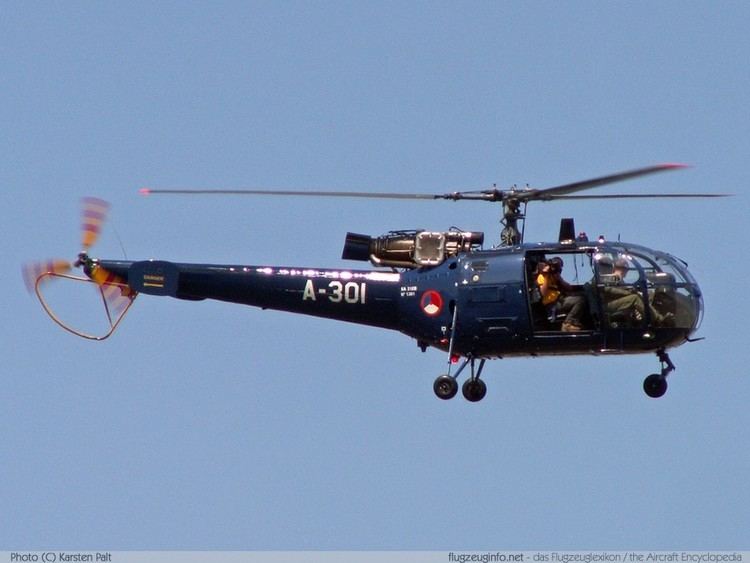 | ||
Manufacturers Airbus Helicopters, Sud Aviation, Aérospatiale | ||
The Aérospatiale Alouette III ([alwɛt], Lark) is a single-engine, light utility helicopter developed by Sud Aviation. It was manufactured by Aérospatiale of France, and under license by Hindustan Aeronautics in India as Hal Chetak, by Industria Aeronautică Română in Romania as IAR 316 and F+W Emmen (de) in Switzerland.
Contents
- Development
- Variants
- Argentina
- Australia
- Belgium
- Chile
- Denmark
- France
- Ireland
- India
- Pakistan
- Portugal
- Rhodesia
- South Africa
- Suriname
- Switzerland
- Venezuela
- Current military operators
- Former military operators
- Specifications SA 316B
- References

The Alouette III is the successor to the Alouette II, being larger and having more seating.
Development
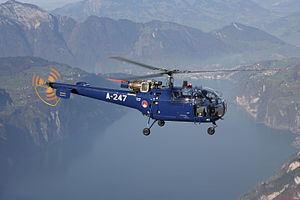
The first version of the Alouette III, the SE 3160 prototype, first flew on 28 February 1959. The SA 316A (SE 3160) entered production in 1961 and remained in production until 1968, when it was replaced by the SA 316B. The last and 1437th Alouette III left the Marignane assembly lines in 1979, when the main production line in France was closed down. The last Alouette III from Aérospatiale was delivered in 1985.
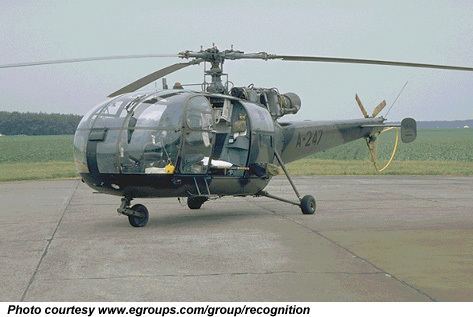
Over 500 units were manufactured under licence in Romania, India, and Switzerland. Hindustan Aeronautics Limited (HAL) obtained a license to build Alouette IIIs as the HAL Chetak in India. Over 300 units were produced by HAL as it continued to independently update and indigence the helicopter over the years, and a variant is still in production though in diminishing volumes. Versions of the Alouette III were also either license-built or assembles by IAR in Romania (as the IAR 316), F+W Emmen (de) in Switzerland, and by Fokker and Lichtwerk in the Netherlands.
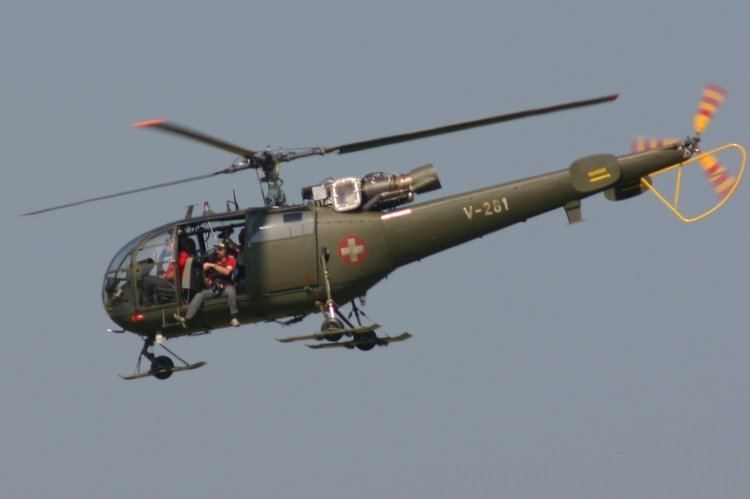
When used as an aerial ambulance, the Alouette III can accommodate a pilot, two medical attendants and two stretcher patients.
Variants

Argentina
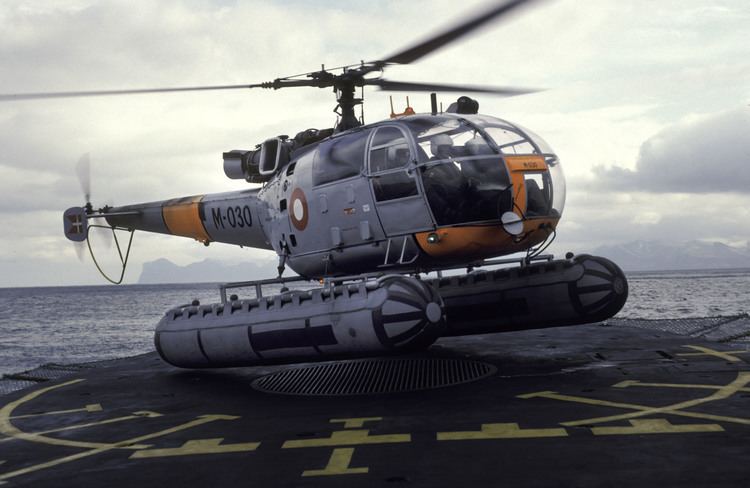
The Argentine Naval Aviation purchased 14 helicopters. One SA316B was on board the ARA General Belgrano when she was sunk by the HMS Conqueror's torpedoes during the Falklands War with Great Britain in 1982 and a second one played an important role during the Invasion of South Georgia. On 2 December 2010, the last example was retired at a ceremony held at BAN Comandante Espora, Bahía Blanca.
Australia
From April 1964 to 1967, three machines were delivered from France for local assembly in Australia. These were used by the Royal Australian Air Force (RAAF) at the Woomera Rocket Range for light passenger transport and the recovery of missile parts after test launches at the Range.
Belgium
Marine / Air Force : 3 × SA.316B
Chile
The Chilean Navy ordered a batch of ten SA-319Bs in 1977. The aircraft were delivered by the middle of 1978 and made operational just before the peak of the Beagle conflict with Argentina, making the first real organic maritime ship borne tactical helicopter operated by Chile's naval forces. They were equipped with a radar and armed with rockets, guns, depth charges and a single light anti-submarine torpedo. A sole SA-319B was damaged during the frantic training period in 1978, but it was placed in storage and repaired back to airworthy condition later. All ten Chilean Navy SA-319Bs were operational and in excellent conditions at the end of the eighties, when they were replaced by SA532 Super Puma helicopters, and were bought by civilian operators.
Denmark
Eight machines were delivered to the Royal Danish Navy from 1962 to 1967. They were primarily tasked with SAR and reconnaissance in support of the navy's Arctic patrol ships. In 1982, they were replaced by the Westland Lynx
France
The Alouette III entered service with the French Armed forces in 1960. The French Army ordered 50 Alouette IIIs in June 1961.
In June 1960, an Alouette III carrying seven people made take-offs and landings on Mont Blanc in the French Alps at an altitude of 4,810 meters (15,780 feet), an unprecedented altitude for such activities by a helicopter. The same helicopter again demonstrated the type's extraordinary performance in November 1960 by making take-offs and landings with a crew of two and a payload of 250 kg (551 lbs) in the Himalayas at an altitude of 6,004 meters (19,698 feet).
In June 2004, the Alouette III was retired from the French Air Force after 32 years of successful service, being replaced by the Eurocopter EC 355 Ecureuil 2.
The French Navy still uses the Alouette III for Search and Rescue and Logistics missions.
Ireland
The Irish Air Corps operated a total of eight Alouette IIIs between 1963 and 2007; for much of this period they were the only helicopters in the Corps. The first two were delivered in 1963, a third in 1964 and five further aircraft between 1972 and 1974. At Baldonnel Aerodrome on 21 September 2007, the Alouette III was retired from the Irish Air Corps. During 44 years of successful service, the Irish Alouette III fleet amassed over 77,000 flying hours. As well as routine military missions, the aircraft undertook some 1,717 search-and-rescue missions, saving 542 lives and flew a further 2,882 air ambulance flights. The oldest of the Alouettes, 195, is kept in 'rotors running' condition for the Air Corps Museum.
India
Hindustan Aeronautics Limited built over 300 units of the helicopter under licence as the HAL Chetak. They were primarily in service with the Indian Armed Forces in training, transport, CASEVAC (Casualty Evacuation), communications and liaison roles. The Chetak is being replaced by HAL Dhruv in the armed forces. An option to re-engine the HAL Chetak with the Turbomeca TM 333-2B engine for high-altitude operations in the Himalayas was considered, but not pursued.
In 1986, the Government constituted the Army's Aviation Corps and most Chetak operating in AOP Squadrons were transferred from the Air Force on 1 November 1986. The Air Force continues to fly armed Chetaks in the anti-tank role as well as for CASEVAC and general duties.
HAL also exported Chetak helicopters to Namibia and Suriname. India has also donated used Chetak helicopters to other countries such as Bangladesh and Nepal.
Pakistan
Pakistan purchased 35 Alouette III helicopters and used them in the Indo-Pakistani War of 1971, mainly for liaison and VIP-transport. Two Alouette IIIs of the Pakistan Air Force (PAF) were shot down during the war.
Portugal
Portugal was the first country to use the Alouette III in combat. In 1963, during the Overseas Wars in Angola, Mozambique and Portuguese Guinea, Portugal began using Alouette IIIs in combat, mainly in air assault and medevac operations, where it proved its qualities. Besides the basic transport version (code named canibal, plural canibais), Portugal used a special version of the Alouette III with a MG 151 20 mm autocannon mounted in the rear in order to fire from the left side door; it was designated helicanhão (heli-cannon) and code named lobo mau (big bad wolf).
In the Overseas Wars, the Portuguese usually launched air assaults with groups of six or seven Alouette III: five or six canibais - each usually carrying five paratropers or commandos - and a lobo mau heli-cannon. The Portuguese practice was for the troops to jump from the canibais when the helicopters were hovering two-three meters above the ground - famous images of these disembarking troops became an iconic image of the war. The landing of the troops was covered by the lobo mau. While the troops performed the ground assault, the canibais moved away from the combat zone, while the lobo mau stayed to provide fire support, destroying enemy resistance and concentration points with the fire from its 20 mm autocannon. Once the ground combat had finished, the canibais returned; firstly to collect the wounded, then the rest of the troops.
At present, the Portuguese Air Force maintains a number of Alouette IIIs in service, mainly for training and SAR. They also equip the aerobatic team Rotores de Portugal.
Rhodesia
At its peak, No. 7 Squadron, Rhodesian Air Force, operated 34 Allouette III, along with a smaller number of Allouette II, in the troop transport, casevac and battlefield support roles. They played a major part in the Rhodesian Forces' "Fire Force" doctrine, both deploying ground troops, acting as observation and command post and providing mobile fire support as gunships.
South Africa
The Alouette III served for over 44 years and flew more than 346,000 hours in the South African Air Force (SAAF), particularly during counterstrike operations in Angola. The aircraft was officially withdrawn from SAAF service at AFB Swartkop near Pretoria in June, 2006.
In early 2013, an interim court order blocked the proposed sale of South Africa's retired Alouette fleet to the Zimbabwean Air Force.
Suriname
In 1999, the Surinam Air Force retired and sold its two Alouette III helicopters from active service. They have been on duty since 1986 in this small South American country bought from Portugal. Three new HAL Chetak Indian version Alouette III's were delivered to the Suriname Air Force on 13 March 2015, while the pilots and technicians of the Surinam Air Force were under training in Bangalore, India for some time.
Switzerland
Swiss air force purchased nine Alouette III in 1964, then 15 more in 1966. 60 SA-316B (F+W Alouette IIIS) were license-assembled by {{{1}}} in Switzerland. In 2004, the Swiss Armed Forces announced the retirement of the Alouette III from front-line service by 2006 (36 Alouette III) and entirely by 2010, 10 of them have been given to Pakistan for rescue duty. They have been replaced by 20 Eurocopter EC635.
Venezuela
The Venezuelan Air Force retired its Alouette IIIs in the late 1990s.
Current military operators
Former military operators
Specifications (SA 316B)
Data from Jane's All The World's Aircraft 1976-77
General characteristics
Performance
